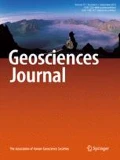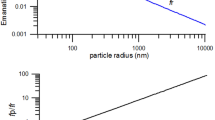Abstract
Interactions between groundwater and aquifer rock can result in anomalously high levels of radium (Ra) and radon (Rn) in groundwaters. An understanding of aquifer mineralogy and determining the sources of natural radionuclides are, therefore, essential to design possible means for improving groundwater quality. The Cambrian Hickory Sandstones and Cap Mountain Limestones constitute important aquifers in the area surrounding the Llano Uplift in central Texas. Groundwaters produced from these aquifers, however, have anomalous concentrations of Ra and Rn, much greater than the maximum contaminant levels (MCL) suggested by the USEPA. To determine the sources of Ra and Rn, the abundance, distribution, and nature of occurrence of U and Th, parent radionuclides of Ra and Rn, were examined in cored aquifer rock samples.
The Hickory, 136 m thick, consists of a coarse-grained sandstone lower submember, a calcareous sandstone middle, and a fossiliferous and hematitic sandstone upper, with thin shale laminae throughout. The Cap Mountain, 44 m thick, is a sandy limestone. Detrital materials are composed of 77% quartz, 19% feldspars, and 4% lithic fragments, and are classified as subarkose. Accessory minerals are less than 1% in average. Authigenic minerals, primarily clay, Fe-oxide minerals and carbonate, make up 18% of the bulk rock. Porosity is of secondary origin.
Analysis of U in a total of 128 sandstone and shale samples shows an average of 3.8 ppm, ranging from 1 to 8.5 ppm. Th concentrations in 21 bulk rock samples range from 8.4 to 18.6 ppm, averaging 13.7 ppm. The U and Th contents are similar to those of the underlying Precambrian granites, from which much of the sediments were derived. The primary modes of U occurrence are in: (1) biogenic materials such as phosphatic brachiopod fragments and intraclasts; (2) thin shaly laminae enriched in phyllosilicates; (3) authigenic minerals, particularly hydroxyl-oxides of iron and clay minerals; and (4) detrital accessory minerals.
Mobilization of U and its decay products by groundwaters can account for the Ra and Rn anomaly in the produced water, particularly interacting with intervals of high concentrations of shaly laminae, phosphatic materials, or iron-oxide cements.
Similar content being viewed by others
References
Altschuler, Z.S., Clarke, R.S. and Young, E.J., 1958, Geochemistry of uranium in apatite and phosphorite. USGS Professional Paper 314-D, 45–90.
Ames, L.L., 1960, Some cation substitutions during the formation of phosphorite from calcite. Economical Geology, 55, 34–362.
Asikainen, M., 1981, State of disequilibrium between 238U, 234U, 226Ra and 222Rn in groundwater from bedrock. Geochimica et Cosmochimica Acta, 41, 201–206.
Askiainen, M. and Kahlos, H., 1979, Anomalously high concentration of uranium, radium and radon in water from drilled wells in the Helsinki region. Geochimica et Cosmochimica Acta, 41, 1681–1686.
Barnes, V.E. and Bell, W.C., 1977, The Moore Hollow Group of Central Texas. University of Texas, Bureau of Economic Geology, Reports of Investigations 88, 169 p.
Burnett, W.C. and Veeh, H.H., 1977, Uranium-series disequilibrium studies in phosphorite nodules from the west coast of South America. Geochimica et Cosmochimica Acta, 41, 755–764.
Cech, I.M., Kreither, C., Prichard, H., Holguin, A. and Lemma, M., 1988, Radon distribution in domestic water of Texas. Ground-water, 26, 561–569.
Cech, I.M., Lemma, M., Prichard, H.M. and Kreither, C., 1987a, Radium-226 and radon-222 in domestic water of Houston-Harris County, Texas. In: Graves, B.J. (ed.), Radon, Radium and Other Radioactivity in Ground Water. Lewis Publishers, p. 377–402.
Cech, I.M., Prichard, H.M., Mayerson, A. and Lemma, M., 1987b, Pattern of distribution of radium-226 in drinking water of Texas. Water Resources Research, 23, 1987–1995.
Cothern, C.R., 1987, Estimating the health risks of the radon drinking water. Journal of American Water Works Association, 79, 153–158.
Fleischer, R.L., 1983, Theory of alpha recoil effects on radon release and isotopic disequilibrium. Geochimica et Cosmochimica Acta, 47, 779–784.
Freed, R.L., 1986, Summary of the Precambrian and Paleozoic geology of south-central Texas. The Compass, 63, 130–144.
Gilkeson, R.H. and Cowart, J.B., 1987, Radium, radon and uranium isotopes in groundwater from Cambrian-Ordovician sandstone aquifers in Illinois. In: Graves, B.J. (ed.), Radon, Radium and Other Radioactivity in Ground Water. Lewis Publishers p. 403–422.
Guthrie, V.A., 1989, Fission-track analysis of uranium distribution in granitic rocks. Chemical Geology, 77, 87–107.
Krishnaswami, S., Graustein, W.C., Turekian, K.K. and Dowd, J.F., 1982, Radium, thorium, and radioactive lead isotopes in ground-waters: application to the in-situ determination of adsorption rate constants and retardation factors. Water Resources Research, 18, 1663–1675.
Langmuir, D., 1978, Uranium solution-mineral equilibria at low temperatures with applications to sedimentary ore deposits. Geochimica et Cosmochimica Acta, 57, 547–569.
Ledger, E.B., 1981, Evaluation of the Catahoula Formation as a Source Rock for Uranium Mineralization with Emphasis on East Texas. Unpublished Ph.D. Dissertation, Texas A&M University, 249 p.
Millard, H.T. Jr., 1976, Determination of uranium and thorium in USGS standard rocks by delayed neutron technique. In: Flanigan, F. (ed.), Descriptions and Analysis of Eight New USGS Rock Standards. USGS Professional Paper, 840, 61–66.
Mills, W.A., 1990, Risk assessment and control management of radon in drinking water. In: Cothern, C.R. and Rebers, P. (eds.), Radon, Radium and Uranium in Drinking Water. Chelsea, Michigan, Lewis Publishers, 99, 27–37.
Milton, G.M. and Brown, R.M., 1987, Adsorption of uranium from groundwater by common fracture secondary minerals. Canadian Journal of Earth Sciences, 24, 1321–1328.
Morawska, L. and Phillips, 1993, Dependence of the radon emanation coefficient on radium distribution and internal structure of the material. Geochimica et Cosmochimica Acta, 57, 1783–1797.
Rama and Moore, W.S., 1984, Mechanism of transport of U-Th series radioisotopes from solids into groundwater. Geochimica et Cosmochimica Acta, 48, 395–399.
Rich, R.A., Holland, H.D. and Petersen, U., 1977, Hydrothermal Uranium Deposits, Elsevier, 264 p.
Rogers, J.J.W. and Adams, J.A.S., 1969, In: Wedepohl, K.H. (ed.), Handbook of Geochemistry, Springer, II/3, sections 90 and 92.
Statens Stralevern, 1994, Action Plan for Further Work with Radon in Norway. Report to the Norwegian Ministry of Health, March 1994, 37 p.
Statens Stralskyddsinstitut, 1993, Radon 1993—En Sapport over Laget [Radon 1993—a Status Report]. Report 93-10, Stockholm, 97 p.
Tieh, T.T. and Ledger, E.B., 1981, Fission-track study of uranium in two granites of central Texas, Contributions to Mineralogy and petrology, 76, 12–16.
Tieh, T.T., Ledger, E.B. and Rowe, M.W., 1980, Release of uranium from granitic rocks during in situ weathering and initial erosion. Chemical Geology, 29, 227–248.
Wanty, R.B., Johnson, S.L. and Griggs, P.H., 1991, Radon-222 and its parent radionuclides in groundwater from two study areas in New Jersey and Maryland, U.S.A.. Applied Geochemistry, 6, 305–318.
Wanty, R.B., Lawrence, E.P. and Gundersen, L.C.S., 1992, A theoretical model for the flux of radon from rock to ground water. Geological Society of America Special Paper, 271, 73–78.
Williams, H., Turner, F.J. and Gilbert, C.M., 1982, Petrography: An Introduction to the Study of Rocks in Thin Sections. W.H. Freeman and Company, 626 p.
Zikovsky, L. and Chah, B., 1990, The lognormal distribution of radon in groundwater. Groundwater, 28, 673–676.
Author information
Authors and Affiliations
Rights and permissions
About this article
Cite this article
Kim, Y. The concentrations and distributions of U and Th in Paleozoic aquifers surrounding the Llano Uplift area, central Texas, U.S.A.: application to the sources of Ra and Rn in groundwater. Geosci J 3, 201–211 (1999). https://doi.org/10.1007/BF02910491
Received:
Accepted:
Issue Date:
DOI: https://doi.org/10.1007/BF02910491




